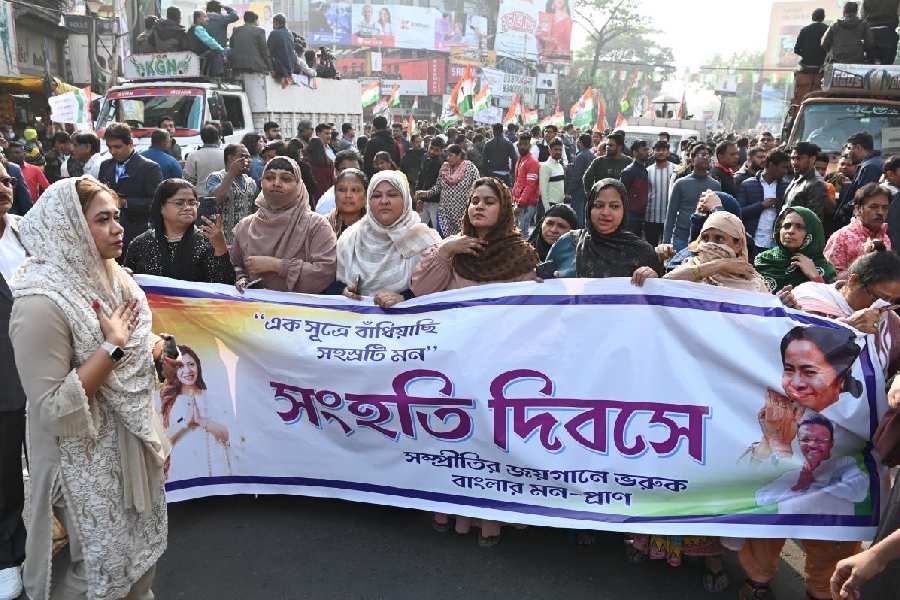Mamata Banerjee’s Sanhati Yatra or interfaith rally on Monday from Hazra Crossing to Park Circus Maidan, which coincided with the opulent consecration of Ram temple in Ayodhya by Prime Minister Narendra Modi, was a picture of inclusiveness as representatives from various faiths and communities took part in the 3.9km march.
Some 40,000 people from the hills to the plains of Bengal made it a colourful congregation in their traditional attire.
Mamata and her party colleagues tried to weave into the one-and-a-half-hour rally representatives from all possible religions, faiths, castes and creeds to showcase Bengal’s diversity in faiths and cultures.
Calcutta apart, Trinamul organised interfaith rallies in each of the 341 blocks.
Mamata, who led the march themed on “religion is personal, the festival is universal”, was accompanied by various religious heads, followed by thousands of women, men, youths and children dressed up to represent various faiths.
The Telegraph spoke to some of those who walked to celebrate India’s unity in diversity.
Indubhushan Utthasini, Hindu priest
The 38-year-old Hindu priest travelled around 80km from his village in East Midnapore’s Mecheda to join the rally as a member of an organisation of priests.
Calling himself a devotee of Lord Ram, he said he worshipped the deity every day. Before leaving home early on Monday for Calcutta, he offered flowers to Lord Ram, Utthasini said.
An arts graduate and a professional priest, Utthasini explained why he took part in the interfaith rally. He said it wasn’t for political reasons but to send a message that the people of Bengal stood for inclusiveness.
“I am a devotee of Shri Ram and I worship him every day. I am happy with the temple that has been built in Ayodhya for our God. But I don’t want
any political party to showcase its power by setting up a
temple in our country. Ram is for all, not just for one particular community or religion. That’s why the rally of people from all faiths is the right way to celebrate the occasion. We all brothers here,” Utthasini said, adding that he would join such rallies in the future too.
Churmit Lepcha, president of the Indigenous Lepcha Tribal Association
Churmit, 40, travelled around 660km from Kalimpong with her friend Khusboo Chhetri, 26.
The woman dressed in traditional Lepcha attire said she travelled the distance to Calcutta to support the inclusive character of the country.
“Our chief minister Mamata Banerjee has done a lot for our community and has tried to preserve the spirit of brotherhood in Bengal. When I heard that she was organising an interfaith rally on January 22, I decided to travel from Kalimpong to Calcutta,” Churmit said.
Nagma Khatun, Muslim resident of Metiabruz
Nagma, 28, is one of the 400 Muslim women from Metiabruz who woke up early to finish her daily chores to participate in the rally.
One of the five women who held a banner of the Sanhati Yatra, Nagma was at the head of a team of around 4,000 women marchers who shouted slogans for amity.
A high-school dropout, Nagma said: “I don’t have any problem with any temple.
We welcome the temple but can’t stand political leaders flexing muscles to celebrate the temple as a victory
over others. Our chief minister always speaks for inclusiveness. Since my childhood, I have seen people of diverse faiths and communities living peacefully in my city. I walked in the rally for peace and harmony.”
Raju Shaw, Vaishnav saint with ISKCON
Shaw, 50, said his family migrated to Bengal from Bihar’s Gaya 35 years ago.
“I took part in the rally as I understand the need for inclusiveness, which is an integral part of Bengal,” said the saint who showed a small bag with “Hare Krishna, Hare Rama” inscribed several times on it.
He always carries the bag that contains his japamala (a loop of prayer beads), he said, adding it meant he always carries the name of Lord Ram in his hands and heart. But he did not support the way the consecration of the Ram temple had become a “political weapon” for a party.
“Ram is in our hearts but why will his august temple be used as a political platform? Here (at this interfaith rally), I am walking with people from all communities and I don’t have to think if someone beside me is from any other religion,” Shaw said.
Shantanu Sarkar, high school student
Santanu, 18, from Bowbazar, dressed up as a Muslim cleric to take part in the rally.
His friends Deb and Saikat, who walked with him, were dressed up like a Hindu priest and a Christian bishop, respectively.
“Can you identify our religion before we tell you our names?” grinned the teenager as he marched on with his friends amid thousands.
He said that recently, local Trinamul leaders asked him and his friends if they were interested in taking part in Monday’s interfaith rally dressed up as leaders of different faiths.
“We immediately agreed. It was a great opportunity to showcase the secular fabric of our country,” Santanu said.










